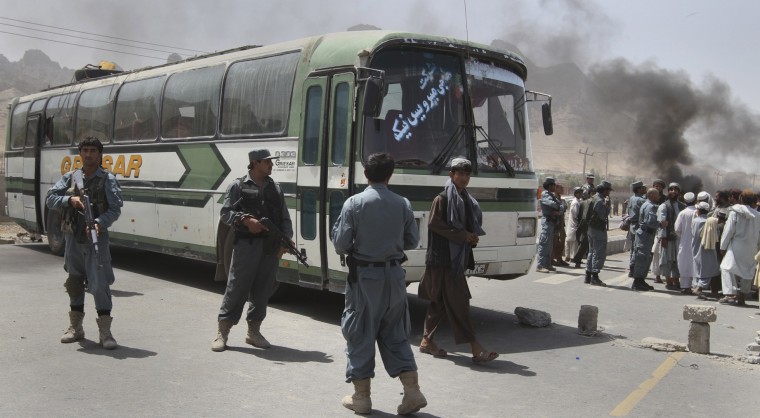U.S. troops opened fire on a bus carrying Afghan civilians Monday, killing five people, officials said, setting off anti-American protests in a key southern city where coalition forces hope to rally the public for a coming offensive against the Taliban.
NBC confirmed the troops were American and that four people were killed instantly, while a fifth died a few hours later of injuries.
The pre-dawn shooting in Kandahar province's Zhari district wounded another 17 people. International forces took 12 of the wounded to a military hospital.
A passenger interviewed at Kandahar hospital said they had just left the Kandahar terminal when the bus pulled over to allow an American convoy to pass. Shooting broke out as the third or fourth American vehicle went by, Rozi Mohammad said, with gunfire coming from the direction of the convoy.
"They just suddenly opened fire, I don't know why. We had been stopped and after that I don't know what happened," said Mohammad, his left eye swollen shut and his beard and clothing matted with blood. Doctors said he had suffered a head injury but did not yet know how serious it was.
NATO had a different view, saying the bus had approached a slow-moving patrol from behind at a high speed and ignored flares and other signals to slow down.
"Perceiving a threat when the vehicle approached once more at an increased rate of speed, the patrol attempted to warn off the vehicle with hand signals prior to firing upon it. Once engaged, the vehicle then stopped," NATO said in a statement e-mailed to reporters.
Accounts of such confrontations often vary widely, and NATO said it was carrying out further investigations together with Afghan authorities.
'Death to America' chants
Within hours of the shooting, scores of Afghans had blocked the main highway out of Kandahar with burning tires, chanting "Death to America," and calling for the downfall of Afghan President Hamid Karzai, himself a Kandahar native.
"The Americans are constantly killing our civilians and the government is not demanding an explanation," said resident Mohammad Razaq. "We demand justice from the Karzai government and the punishment of those soldiers responsible."
Karzai issued a statement condemning the attack and expressing condolences to the victims.
"This shooting involving a civilian bus violates NATO's commitment to safeguard civilian life," Karzai said.
NATO is gearing up for a long-anticipated allied operation to push the Taliban out of Kandahar, from which the hardline Islamist movement emerged as a political and military force in the 1990s.
The city's mayor said Monday's shootings would likely deal a major setback to coalition hopes of winning popular support for that upcoming offensive.
"I've told the Americans and NATO that people are very angry about these kinds of attacks," Gulam Hamidi told The Associated Press. "I've told them 'You're making enemies.'"
The top NATO commander in Afghanistan, U.S. Gen. Stanley McChrystal, has issued strict orders to his troops to try to reduce civilian casualties. But they still occur regularly, unleashing raw emotions that highlight a growing impatience with coalition forces' inability to secure the nation.
Kandahar, the largest city in southern Afghanistan, was the birthplace of the Taliban regime ousted in 2001 and insurgents remain active there despite a heavy presence of foreign forces. Securing it is key to the U.S. military and NATO's aim of turning around the more than eight-year war, but anger stirred by civilian deaths threatens to undercut local support for the central government in Kabul.
More than 80,000 U.S. troops are in Afghanistan, many of them deployed to volatile southern provinces including Kandahar.
Suicide bombings
Elsewhere in the city of Kandahar, three suicide bombers attacked an Afghan intelligence services compound, but security forces who opened fire repelled them, said the spokesman for the government of the surrounding province, also called Kandahar. Four intelligence agents and six civilians, including a teacher at a nearby school were wounded in the attack, said the spokesman, Zelmai Ayubi.
Afghan forces with automatic weapons engaged the bombers who attempted to scale the wall of the compound, wounding one who then detonated his explosives belt, Kandahar Gov. Tooryalai Wesa told reporters.
A second bomber also blew himself up, but the third, identified as Najibullah, was captured and being questioned, Wesa said. He said the man told them he was a native of Parwan province just north of Kabul, and had been brought to Kandahar four or five days before.
In another attack, five members of a single family were killed and two wounded in a roadside bombing in the Bala Buluk district of the northwestern province of Farah on Monday afternoon, according to provincial spokesman Ahmad Farid Ayubi. There was no immediate claim of responsibility, although such bombs are a hallmark of the Taliban insurgency.
With troop levels rising amid heightened violence, at least 2,412 Afghan civilians were killed in fighting last year, an increase of 14 percent from 2008, according to the United Nations. The U.N. attributed 67 percent of those deaths to insurgents who use ambushes, assassinations and roadside bombs to spread terror, undermine development and punish Afghans seen as cooperating with foreign forces and the Karzai government.
NATO earlier this month confirmed that international troops were responsible for the deaths of five people, including three women, killed Feb. 12 in Gardez, south of Kabul. An Afghan government report on the incident claims U.S. special forces had mistaken their targets and later sought to cover up the killings by digging bullets out of bodies, according to investigators who requested anonymity because they were not authorized to speak with the media.
